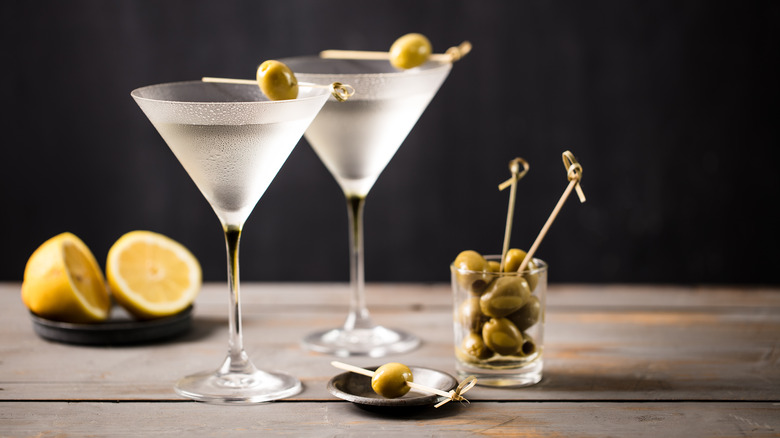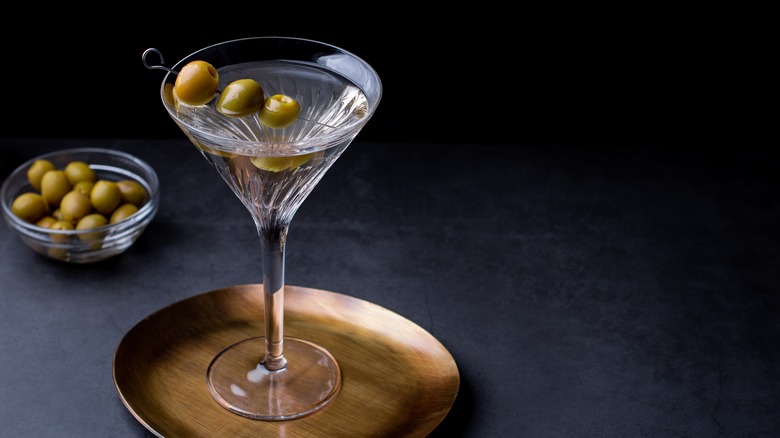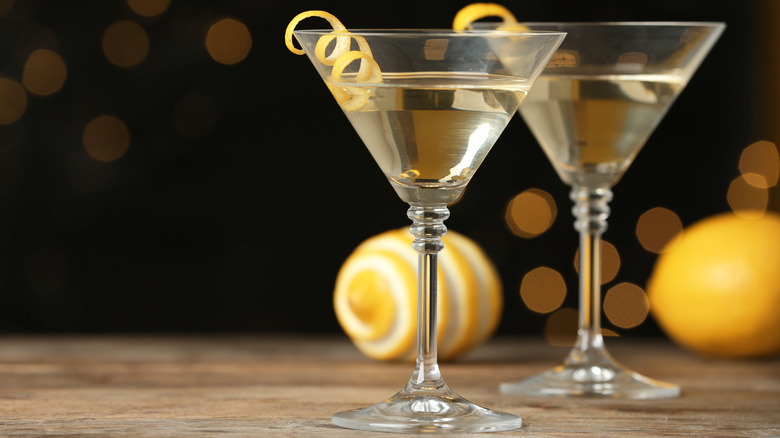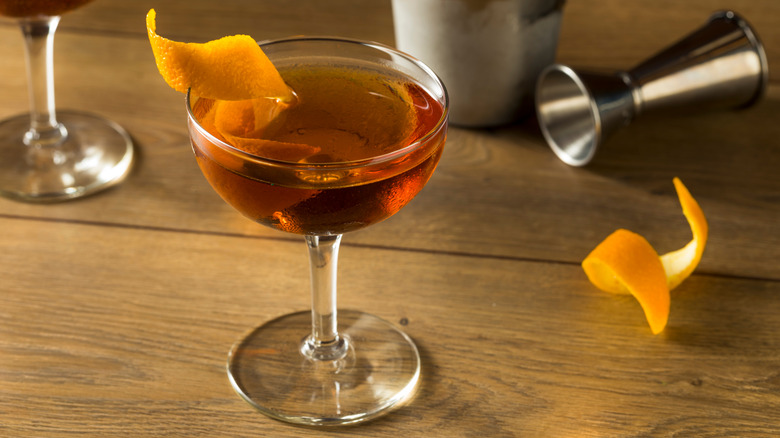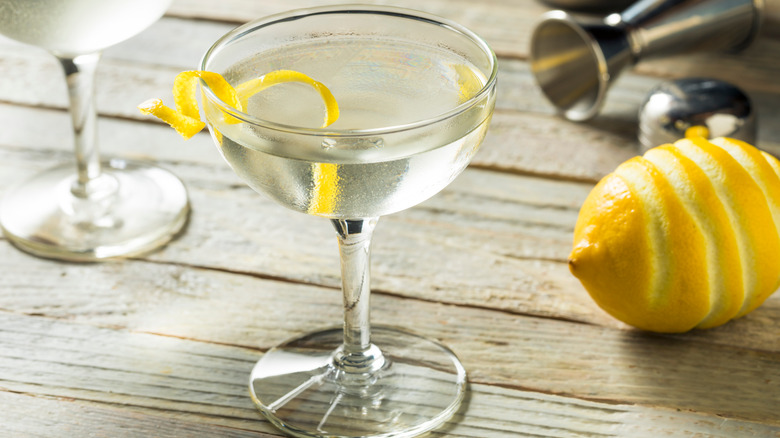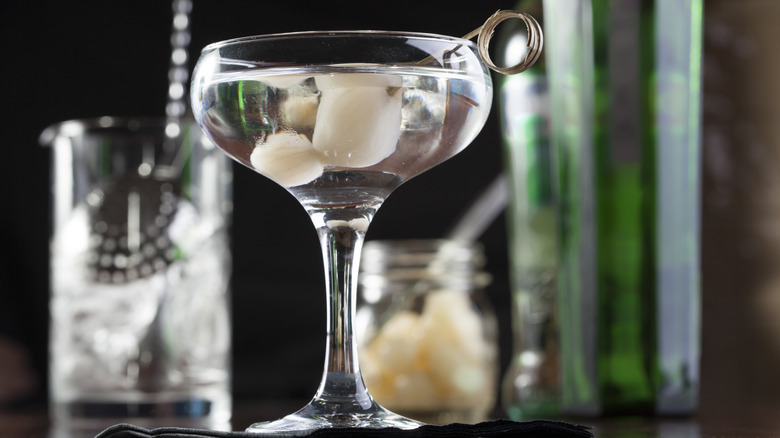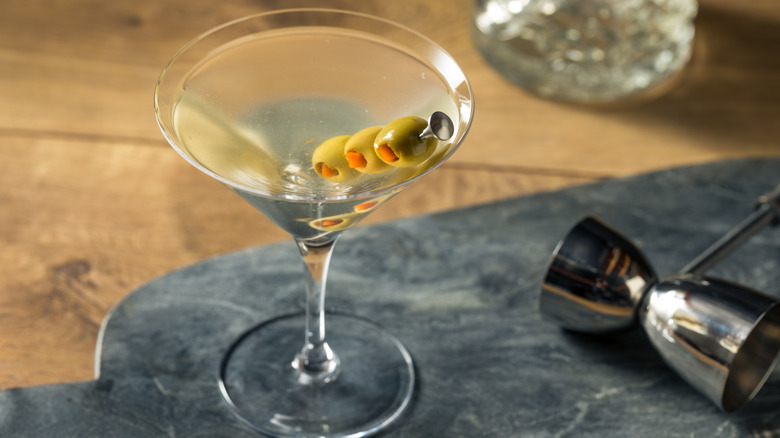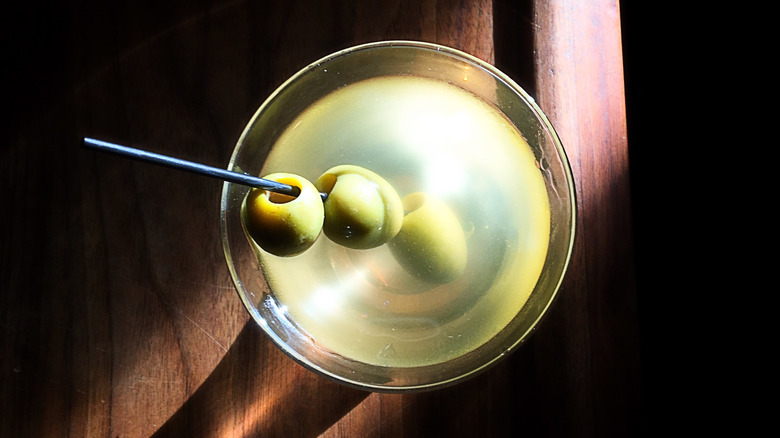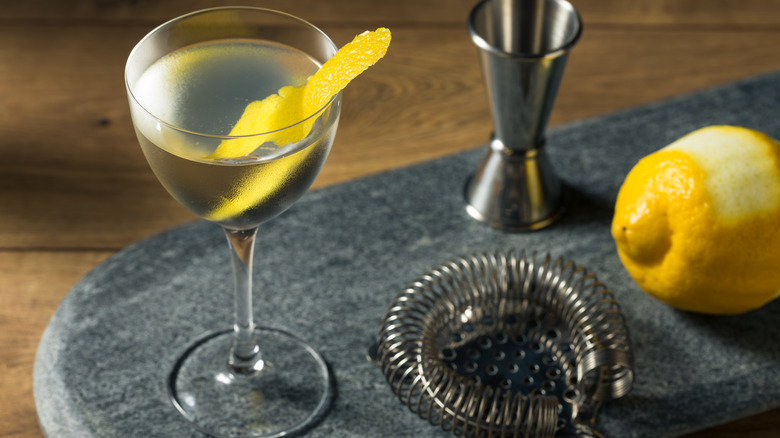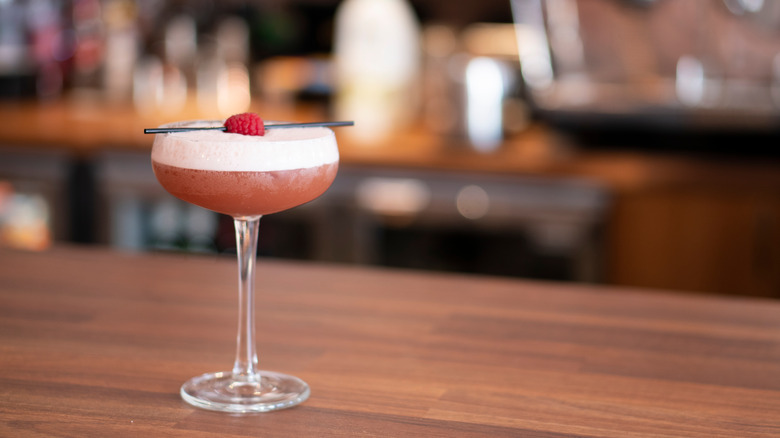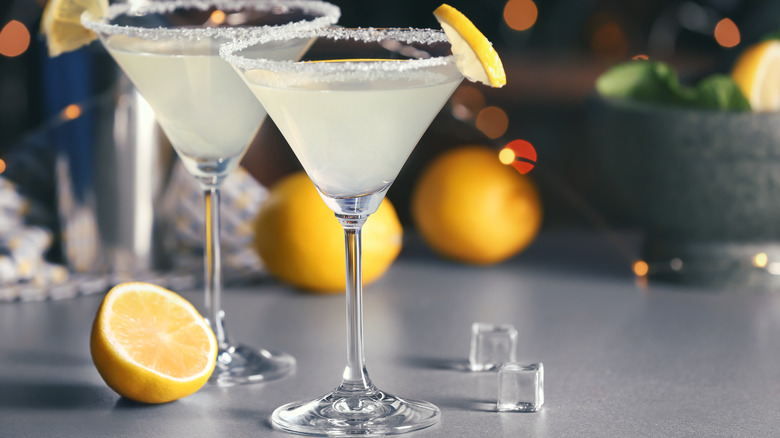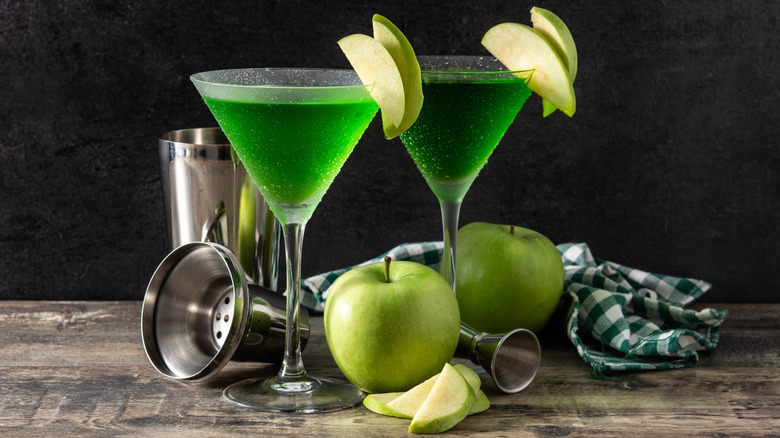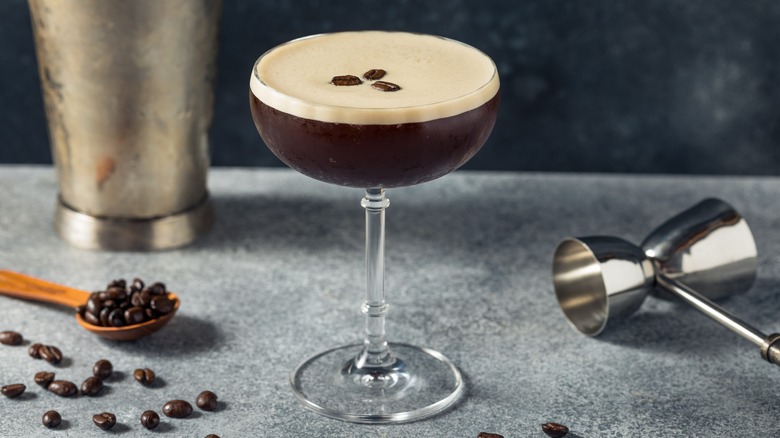13 Martini Variations, Explained
We may receive a commission on purchases made from links.
There is perhaps no cocktail that emits more class and elegance than the martini. The exact origins of the martini are not concrete, but the iconic drink most likely evolved from the Martinez, invented sometime in the mid-19th century (via Difford's Guide). By the early 20th century, other variations of the Martinez like the Margueritte, Martina, and Martineau eventually paved the way toward the classic martini that has been a cornerstone of drinking culture for over a century.
The specifications of the classic martini cocktail recipe are considered to be a couple of dashes of orange bitters, 2 ounces of gin, 1 ounce of dry vermouth, and a citrus peel twist. It's crisp, it's clean, it's smooth, and it's timeless. This framework, however, leaves the door open for experimentation. The creativity, whether subtle or bold, can result in a preferred way to enjoy the cocktail or in a brand new drink altogether.
The martini has probably been stirred billions of times by now, and there are no signs of the drink slowing down any time soon. Ordering the cocktail, however, will most certainly be followed by a question about your personal martini preference, which can be an intimidating inquiry full of unfamiliar terminology for beginners. So, here is your guide to finding your next reliable martini go-to that is sure to never go out of style.
Dry martini
Of all the styles out there, the dry martini is among the most popular, maybe even more so than the classic. Instead of mixing 2 ounces of gin with 1 ounce of dry vermouth, the gin is increased and the vermouth is decreased, making for an even boozier libation. Some dry martinis will be made with maybe 2½ ounces of gin to ½ an ounce of vermouth, while others use the vermouth as sparingly as a rinse. If ordering a martini "very dry," the bartender may just stir the vermouth alone with the ice to coat it, strain out the leftover vermouth, and then use the coated ice to chill and dilute the gin and bitters. Again, how everyone likes their martini is up to personal preference, and there is really no martini style more up to interpretation than a dry martini.
The dry martini came about shortly after the spike in popularity of the original martini, sometime in the 1910s, per Difford's Guide. The early recipes for the dry martini are not what we recognize today, however, as many of them label the drink as "dry" because it omits the use of simple syrup, which is no longer used in modern martinis anyway. As mentioned earlier, the general dryness of the dry martinis of today does not resemble the originals mixed over a century ago. Today, dry martinis are almost a game of achieving the driest cocktail possible, using the vermouth merely as a bystander.
50/50
For those who are definitely not into a dry martini, or even find a classic martini too harsh, the 50/50 martini may be for you. The recipe for this martini variation is exactly how it sounds, equal parts gin to vermouth for a more palatable cocktail.
The emergence of the 50/50 martini can actually be attributed more to the 21st century (via Punch). However, the very first renditions of the martini actually called for an equal parts cocktail consisting of Old Tom Gin and sweet vermouth, versus the dry vermouth used now. This original recipe did not last long, however, and the drier the martini got over the years, the less common the equal-parts version became. That was until legendary bartender Audrey Saunders brought her preferred 50/50 to the opening menu of the iconic Pegu Club in New York City in 2005. Since then, bartenders in New York and beyond have taken to the equal-parts style and it has caught on quite a bit.
According to Saunders, the 50/50 is an encapsulation of culinary balance as opposed to just alcoholic abundance, achieving proportionate attention to both flavor and detail. Of course, there is a dispute as to whether or not the 50/50 martini is actually a martini, but if you find it enjoyable, then that's how the bartender should make it for you. You can rest assured there are plenty of others who prefer theirs just the same.
Reverse Martini
If a 50/50 martini is still too punchy for your taste, the reverse martini is another step further toward approachability. Just like the 50/50, the reverse martini is exactly what it sounds like, as the amounts of gin and vermouth are swapped to make a cocktail that is two parts vermouth to one part gin. If you have ever heard someone ordering their martini "wet," this is what that means.
Reverse martinis are not only good options for those who do not have that taste for such a strong alcoholic bite, but they also have a lower ABV so you can enjoy more of them for longer or just one to ease into the night — you get the crystal-clear elegance of the classic cocktail without the worry of overdoing it too soon. This take on the martini will also accommodate those who have a taste for and love the function of aperitifs. Plus, a reverse martini will do well to get your digestive system working and your appetite ready for the evening ahead.
The reverse cocktail template is not only applicable to martinis, however, as Reverse Manhattans and Reverse Daiquiris are also common, low-ABV riffs on iconic drinks.
Martinez
The Martinez is the cocktail that pre-dates the martini, so technically the martini is a variation of the Martinez. Nevertheless, it is well worth a spot on this list. The Martinez is known to be invented sometime in the 1800s in California during the Gold Rush, but the first published recipe of the cocktail did not come until the 1880s when it was published in The Bartender's Manual (via Difford's Guide). However, there was no explicit recipe for the Martinez. Instead, the recipe just said to make a Manhattan and substitute the whiskey for gin.
The recipe, evolving further, was published again in an 1887 reprint of Jerry Thomas's Bartender's Guide (first published in 1862). This recipe includes one dash of bitters, two dashes of Maraschino liqueur, one measure of Old Tom Gin, and one measure of French vermouth. This recipe is the closest early iteration of what is now considered a Martinez. Recipes nowadays make a clear distinction between "sweet vermouth" as opposed to "French."
The Martinez is a classic drink that deserves a try from any cocktail aficionado. If you like martinis, this drink is more complex and mellow which gives that dryness of gin but is balanced out by the sweet vermouth, as opposed to dry. Plus, the very small amount of maraschino liqueur brings some extra nuance and depth for a cocktail on the sweeter, more approachable side.
Turf Club
The Turf Club (also known as Tuxedo No. 2) gets its name from the gentlemen's clubs of the early 1900s (via Difford's Guide). These venues were not the same as what the term "gentlemen's club" means today. Turf is a reference to the surface of racing tracks and these were more like social clubs where men would gather to eat, drink, and gamble.
Of course, the classic cocktails of the time were commonly mixed and enjoyed at these merry meeting places, and as the martini came into the limelight, the cocktails were riffed on to make something more suitable for these clubs. The first recipe for a Turf Club cocktail was actually the closest to what a 50/50 martini is known as today. First published in "How to Mix Drinks: Bar-Keepers Handbook" in 1884, the Turf Club recipe called for gin, dry vermouth, and bitters, but the drink eventually evolved into what it is today which adds maraschino liqueur and absinthe.
The equal parts gin and vermouth ratio may not be your preferred martini, but if a drier martini is your preference, the Turf Club provides that same dryness with a wider array of flavors. The dryness of the absinthe provides that kick and bite, while the maraschino liqueur brings some added fruitiness to complement the bitters.
Gibson
The only main aspect of the classic Gibson cocktail recipe that makes it different from a regular, traditional martini, is its garnish. While the typical martini is garnished with a citrus twist or olives, the Gibson is garnished with onions.
The origins of the Gibson are not exactly clear, but there are two possible stories behind the drink's invention. The first would have occurred in the early 1900s and is attributed to Charles Dana Gibson, whose supposed request to the bartender at the Player's Club in Manhattan to improve his martini was adhered to by an onion being dropped into it (via Slate). The other possible origin of the drink comes from 1890s San Francisco when a businessman named Walter D.K. Gibson believed a daily dosage of onion would help prevent the common cold, so he requested one in his martini.
While the lack of bitters and the presence of onion make for only minor differences, they go a long way in making a cocktail that is its own thing while not being completely unfamiliar. The Gibson is a savory cocktail and the perfect aperitif before a savory meal ahead. If you come across cocktail onions in the store, give this one a shot.
Kangaroo (vodka martini)
The Kangaroo, or vodka martini, is probably the classic martini's biggest competitor. Vodka simply subs in for gin in this cocktail and can be broken into any specification the traditional gin martini can. There can be a dry vodka martini, a 50/50 vodka, a martini, a reverse vodka martini, and so on. Because vodka is flavorless, however, the flavor notes of a Kangaroo rely entirely on the vermouth, the bitters, and the garnish. The juniper-forward botanicals of gin provide most of the martini's flavor profile, so swapping it out for vodka really does make for an entirely different cocktail.
It is not known why the vodka martini's original name is a Kangaroo, but the cocktail is always referenced or ordered as a vodka martini now anyway. What is known about the vodka martini or vodkatini, the origin is the spike in the spirit's popularity following the repeal of Prohibition, per Junkee. Somewhere, at some time, vodka was used to make a martini and it caught on.
While the flavorlessness of vodka may cause martini purists to denounce the cocktail as a martini abomination, its vodka's neutrality actually makes it many people's preferred choice for the cocktail. Not everyone like juniper-based gin, so a simple swap for vodka and maybe a lessened presence of vermouth make for an even cleaner, smoother sip. The point is, if you enjoy a vodka martini, don't let anyone tell you your cocktail is a fraud.
Dirty martini
One reason vodka is preferred for martinis is it leaves room for adding some olive juice and turning the cocktail into a Dirty Martini. The Dirty Martini came about around the same time as the classic martini during the early 1900s. A bartender tried muddling olives into the mixing glass with the other ingredients, which led to him utilizing olive brine, according to Spirits Hunters. While the unusual concoction did take some time to catch on, the Dirty Martini has since become an all-time greatest hit and was even the favorite cocktail of President Franklin D. Roosevelt.
The Dirty Martini is not only a bold and almost impressive order, it is a great cocktail to have before a meal to kick your digestion into high gear. The cocktail has been popular for decades, but it suddenly saw a resurgence, especially among younger drinkers in their twenties. Like the Kangaroo, the Dirty Martini has struck up controversy over its legitimacy, not to mention the polarization of pro versus anti-olive people.
Most bartenders will assume the use of vodka in a Dirty Martini, given its neutrality to allow the olive brine to shine, but gin is just as viable an option. As is the case with any cocktail, if you prefer gin, use gin. If you want the olive juice to be the dominant flavor, use vodka. If you are one of those people who are repulsed by olives and avoid them at all costs, maybe skip this one altogether.
Vesper
You may be wondering how on earth a James Bond reference hasn't been made yet in this article on martinis. Well, here it is. In Ian Fleming's 1953 novel-thriller, "Casino Royale," James Bond orders a martini by saying, "Three measures of Gordon's, one of vodka, half a measure of Kina Lillet. Shake it very well until it's ice-cold, then add a large thin slice of lemon peel. Got it?" A few chapters later, Bond is beguiled by the beautiful Vesper Lynd, her name attributed to the cocktail, and the Vesper Martini was born (via Berry Bros & Rudd).
It should also be noted that James Bond's iconic instruction of "shaken, not stirred" is generally not the preferred way to order a martini. Shaking any cocktail adds a less controlled amount of dilution, and is rather done to bring the cocktail to a colder temperature faster. Over-dilution is an enemy of the martini, so stirring the cocktail allows for dilution at a more controlled pace.
As to why Bond orders his martini shaken, a Redditor posits that the reason is that the over-dilution weakens the cocktail. So, as Bond sips on his martini, it appears he is inebriating himself to those around him, when, in actuality, he's his super sharp self. The amount of alcohol in the drink is the same no matter how it is made, but the theory is amusing. Regardless of whether you want to enjoy your Vesper Martini in its authentic form, it most certainly deserves a try either way.
French Martini
The rest of the martinis on our list are all bound to have received flack from martini purists claiming they are not real martinis because of their lack of vermouth, their inclusion of citrus juice, or other factors. Regardless, these cocktails, including the French Martini are commonly found on cocktail menus and are listed as martinis, so it's a good idea to familiarize yourself with some of them.
The French Martini combines 1 ounce each of vodka and Chambord, which is a raspberry liqueur, and 2 ounces of fresh pineapple juice. This drink is labeled French because Chambord is an iconic French spirit that has been produced in the Loire Valley since the late 1600s. The French Martini is known to have popped up around the 1980s or 1990s, and while it obviously does not follow the traditional specifications of a martini, it was labeled as one nonetheless, per Money Inc.
This cocktail is very vibrant and refreshing. The vodka's neutrality paves the way for the Chambord and pineapple juice to compliment each other above that subtle alcoholic bite below. The French Martini is a simple and elegant cocktail perfectly suited for the warmer weather and is definitely worth trying if you already have a bottle of Chambord handy.
Lemon Drop
The Lemon Drop is another bright, straightforward cocktail that is sure to bring some refreshment on a hot day. If a more tart, citrus-forward cocktail is your usual go-to, such as a Gimlet or Daquiri, the Lemon Drop will be right up your alley.
The original Lemon Drop is credited to Henry's Africa, a bar in San Francisco that invented the cocktail in the 1970s, according to Chilled Magazine. Henry's Africa was what was known as a "fern bar," an upscale lounge for singles to meet. The exact bartender who came up with the recipe consisting of vodka, lemon juice, triple sec, and simple syrup is unknown, but the cocktail became popular after its creation. Lemon Drops are typically served in a cocktail glass with a sugar-coated rim, which adds an extra layer of texture and sweetness to balance out the tartness. The name "lemon drop" is a reference to the classic candy.
The Lemon Drop saw a revival in 2006 when it was featured on an episode of the "Oprah Winfrey Show." Rachel Ray's guest appearance featured the two making a Lemon Drop, and Ophra, herself, declaring it her favorite cocktail.
Appletini
This cocktail is the newest martini variation on this list, first created in 1997 at Los Angeles bar Lola's (via Thrillist). The Appletini is a simple combination of vodka and Sour Apple Pucker, an apple-flavored liqueur, and some bartenders will add triple-sec to the mix as well. The apple liqueur used really does not taste like real apples at all, but rather that intense, artificial apple flavor found in candy or fruit-flavored chewing gum. Appletinis are packed with sugar, which is probably why they've been discouraged by the machos in drinking culture.
Quite honestly, whether you prefer stiff or sweet drinks really has nothing to do with the Appletini because it is kind of in a category of its own. Regardless, Appletinis can still be found on cocktail menus, so if you have encountered it before and were not exactly sure what it is, now you know. Just proceed with caution.
Espresso Martini
The final martini on this list has become just as popular and widely enjoyed as any other on this list, including an original martini. The Espresso Martini was invented in the early 1980s by the legendary bartender, Dick Bradsell, at Fred's Club in London, according to GQ. Apparently, a customer sat down at the bar and requested a drink that would "wake me up, then f**k me up." Bradsell obliged and shook together 2 ounces of vodka, simple syrup, Kahlua (coffee liqueur), and a shot of espresso and the rest is history.
Since then, the Espresso Martini has become a worldwide phenomenon and the unofficial king of modern cocktails. The foamy head garnished with three humble espresso beans is what really gives the Espresso Martini that cosmopolitan elegance. It's a relatively simple cocktail but achieves so much on a variety of levels, just as the first customers requested. The intense coffee flavor and espresso provide a caffeine kick to satisfy a coffee craving but are balanced out by the vodka to level everything so another can be had right after. The Espresso Martini is the ultimate after-dinner cocktail, and if you still haven't had one yet, make sure this is the next cocktail you order.
